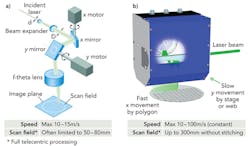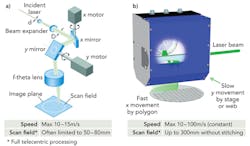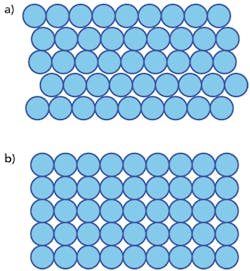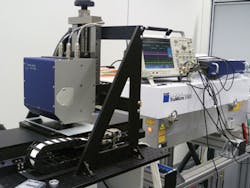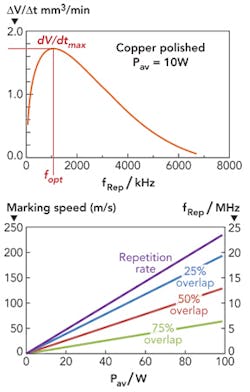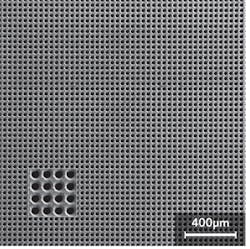Mega-speed and precision laser micromachining
Ultrashort pulses match with polygon line scanner
RONNY DE LOOR and RICK SLAGLE
The photonics industry has recently seen a number of new, high-output-power, ultrashort-pulse (USP) lasers operating in the megahertz regime. These systems have been industrialized for micromachining applications and are on the cusp of replacing environmentally unfriendly processes such as chemical etching. However, they lack a suitable beam-deflecting optical system to fully exploit their high pulse repetition rate (PRR) for maximum throughput—and compete with low-cost but labor-intensive techniques.
High-precision laser micromachining requires an exact synchronization of the laser pulse train and a linear stage to ensure, for each single pulse, a precise control of the laser spot position on the target to within a few microns.
Although many ultrashort-pulse laser micromachining processes have been developed in research labs, not many have reached industrial applications as of today. The main factors hindering the industrial acceptance are the hurdle of capital investment and lack of throughput by the absence of power and scanning speed. In the last two years, high average ultrashort pulsed power of 50W and greater has become available from a number of companies. However, today's laser scanner technology used in laser material processing applications is mostly galvo scanner-based.
A need for higher scanner speeds has arisen to efficiently take advantage of higher pulse rates. Galvo scanner suppliers have responded by tweaking up the writing speed. Despite all the effort, spot scanning speeds higher than 10m/s cannot be achieved when using small spot sizes to process at micron accuracy.
Next Scan Technology (NST) offers a radically different scanner technology capable of moving the focused laser spot at 7.5m/s to 100m/s and higher. This system does not use a set of galvo scanners (FIGURE 1a), but relies on rotating or polygon scanner technology (FIGURE 1b).
This novel approach deflects the incoming laser beam by means of a multifaceted mirror or polygon. The polygon is rotating at a fixed speed around a mechanical axis and every time a flat facet of the polygon traverses the incoming beam, an angular deflected scanning beam is produced. When the beam traverses the corner between two faceted mirrors, the laser is shut off and the beam position flips to beginning of the line again.
By design, rotating scanners are one-dimensional, producing a scanned line. To obtain a 2D scanning system, a secondary linear motion (stage or roll-to-roll) is required. The direction of the secondary motion is perpendicular to the line scanned by the polygon scanner, and is synchronized in speed with the latter rotational speed to obtain a line by line scan of the target surface. This type of scanning is usually referred to as "raster scan."
Polygon scanner technology is well known in the graphic arts industry and today is used in desktop laser printers, where it can be seen as a "hardware" implementation of the raster scan mode. Also, because of the hardware implementation, it delivers at much higher scanning speeds.
Because of the high scanning speeds obtained, laser/scanner synchronization has now become even more necessary (FIGURE 2). It is essential to have a master controller compatible with master oscillator power amplifier (MOPA) ultrafast laser configurations and high PPR nanosecond pulsed fiber lasers to obtain best-in-class throughput and repeatability of laser dot writing positions.
The polygon laser scan engine
The system consists of a state-of-the-art polygon laser scanner and a system controller box. Combined with a laser and linear stage, a high-speed laser writing setup can be operational in a few hours (FIGURE 3).
The scanner unit consists of the rotating polygon, input optics, and unique f-theta optics. With this platform, the f-theta optics are fully telecentric, offering a scanning beam that is always directed perpendicular to the scanned surface and a diffraction-limited, round focused spot across the entire scan width. The optical design is fully reflective (including the f-theta) with reflective coatings for both infrared (IR) and green in one design. The focal length is equal for all wavelengths. With an all-mirror design, operating at 355nm simply requires ultraviolet (UV) reflective coatings.
The scan grid shows no pincushion distortion. No error compensation tables are required to achieve accuracy better than 5μm. Combining a linear stage movement with a one-dimensional f-theta mirror pair enables construction of a simple, yet robust system.
The combined synchronization of polygon speed, stage speed, and laser pulse timing defines a two dimensional grid of laser writing positions. All patterning of the surface must now be handled by selectively gating the laser at the defined grid positions. The information visible on this display can now be stored in a bitmap file. The master controller draws on an Ethernet connection to receive black and white bitmaps. The information in the bitmap is used to gate the laser pulses as the laser beam scans the 2D surface.
Although polygon scanning is not new, there is limited information available on material processing efficiency. The need for scanning speed is recognized by theoretical modeling and experimental verification of material volume rates [1, 2]. This research concludes that there is corresponding optimum pulse energy for maximal volume ablation.
Using higher pulse energy while keeping the PRR constant will ablate more material, but the removal rate does not scale linearly with the pulse energy. When keeping the pulse energy at the optimum level and raising the PRR, the material removal rate does scale up linearly. So, when higher average laser power becomes available, we should work at higher PRR to obtain highest material removal rates. Typical operating conditions for copper at 1064nm and 1W of average power equate to 60kHz; for 50W, this optimal operating point scales up to 3MHz. In the case of a 25μm spot with a 60 percent overlap (10μm pulse spacing) this would require a scan speed of 30m/sec. (FIGURE 4)
Applications
Polygon scanning enables lasers to address large markets in targeted applications [3]. In general, these markets and applications require extremely high throughput, high accuracy, and repeatability, whether over small areas such as 50mm or large areas in excess of 1m. Also, it will enable laser technology to address the following industrial applications next:
2.5D surface shaping. There is a great deal of interest in using lasers to modify the surface of a material to change its inherent characteristics requiring high-density laser pulses delivered over large areas; for example, to make a surface hydrophobic on headlights and windshields of automobiles where water sheds off easily, or to make high-precision tooling for security printing. The laser must process 80 percent or more of the entire surface requiring high pulse rate and high scan speed. In the example shown in FIGURE 5, multi-passes are used where each layer is processed with a different bitmap. Using a 4.1MHz laser at a line scan speed of 60m/s results in a 14.5μm (1.750 dpi) spot spacing, and requires only 24s/layer.
Thin-film patterning and de-coating. An ideal application for megahertz lasers is patterning the transparent conducting oxide (TCO) on the glass of smartphones, with over 800 million sold last year. In addition, larger format glass in tablets, computer monitors, and televisions are increasingly offered with touch-screen capability. Only a single laser pulse per location is required, whereby the laser isn't machining the TCO layer but attacking the interface of the TCO and glass, lifting off the thin film. Pulse energies of only a few microjoules are sufficient, but high write speed is vital to compete with the standard process of using chemical etch. Also de-coating applications (such as paint stripping of aircraft) are being addressed. The high number of scan lines and large area coverage of 300mm elevates throughput to an unprecedented level.
High-density hole drilling. Polygon scanning can be applied in percussion hole drilling with advanced controls on speed and pulse timing. A scan rate ranging from 200 to 1400 lines/s delivers a percussion drilling process in a multipass operation. With its high spot repeatability, thousands of holes per second can be applied, which challenges legacy processes such as through-silicon vias and high-density hole patterns for filter applications (FIGURE 6). An additional benefit is the range of laser sources that can be incorporated, from continuous-wave (CW) and nanosecond pulsed fiber lasers—modulated by an external acousto-optic modulator-to ultrafast lasers.
Scribing, grooving, and dicing. For cutting applications, multiple passes are required, regardless of galvo or polygon scanning. For a 1MHz UV laser with a 15μm spot, the minimum resolution is approximately 25μm to meet the minimum polygon speed of 25m/s, which would result in a spot separation of 10μm. This simply requires a different way of thinking about how you approach scribing applications.
The beam can be delayed slightly to subsequently fill in the unexposed areas. The more passes to cut through or scribe to a certain depth homogenizes the exposure across the line so that uniform depth is achieved. Where a single round pulse can remove some material, overlap of pulses is required to avoid scalloped edges. Multipass processing is an acceptable technique without any throughput penalty or compromise in quality.
The emergence of a new class of high powered ultrashort and nanosecond lasers operating at megahertz pulse rates requires a new way of delivering these pulses over large areas to be commercially economical. Polygon scanning can match the speeds of these lasers while rivaling the accuracy and repeatability only available from a fixed beam, stationary mirrors, and focusing lenses. Megahertz lasers can now produce mega-speed in micromachining.
Acknowledgement
SuperSync is a trademark of Next Scan Technology.
REFERENCES
[1] B. Neuenschwander, B. Jaeggi, M. Schmid, V. Rouffiange, and P-E Martin, "Optimization of the volume ablation rate for metals at different laser pulse durations from ps to fs," Proc. SPIE, 8243, 824307 (Feb. 9, 2012).
[2] B. Jaeggi et al., "High throughput and high precision laser micromachining with ps-pulses in synchronized mode with a fast polygon line scanner," Proc. SPIE, 8967, 89670Q (Mar. 6, 2014).
[3] See introductory film on applications at www.nextscantechnology.com.
RONNY DE LOOR([email protected]) and RICK SLAGLE are with Next Scan Technology, Evergem, Belgium.
